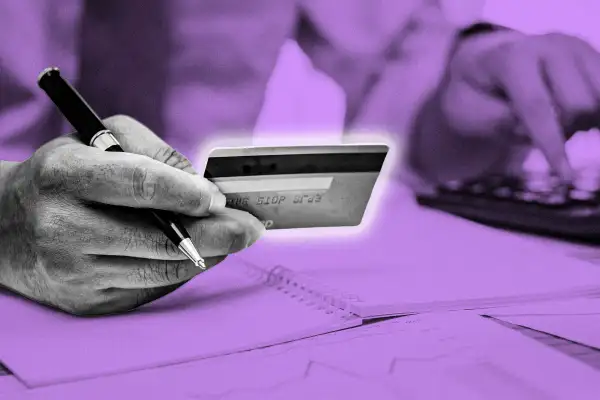3 Warning Signs That You Have Too Much Credit Card Debt

Americans now carry 8% more credit card debt than a year ago and owe $6,239, on average, as rising prices and higher interest rates strain our wallets and make repaying our outstanding balances more difficult.
Despite our growing debt, delinquency rates inched down at the end of last year — bucking a three-year trend of rising credit card delinquencies. So how can you know when your charging reaches a risky level? How can you tell when you’re taking on too much debt?
“The easy answer is any amount that cannot be paid off each month is too much because of the cost to carry credit card debt,” says credit expert John Ulzheimer, formerly of FICO and Equifax.
With credit cards charging an average interest rate of almost 22%, even small balances can balloon quickly, especially if you continue spending. But avoiding credit card debt altogether is not always possible — nor the reality for more than half of users.
If you’re carrying a balance, look out for the following signs, as they can signal that you’re in danger of losing control of your debt payments.
Sign No. 1: Your financial health is suffering
While your debt makes up one piece of your finances, successfully managing it could come at the cost of your overall money wellbeing. For instance, only a quarter of households carrying credit card debt feel confident they are on track to achieve their long-term financial goals, according to a survey by the Financial Health Network.
“If you are feeling strained or even beginning to feel strained, that's a pretty good clue you have too much debt,” says Rod Griffin, senior director of public education and advocacy for credit bureau Experian.
You want to be able to make your monthly debt payments while also still affording your other money goals like building up emergency savings or setting aside funds for retirement, Griffin adds. “For some, this means even a very small amount of debt could be too much, as it's not about the size of the debt itself but its impact on their financial life.”
Another way to look at your credit card debt’s effect on your finances comes down to the proportion of your monthly income it consumes.
Keep your total household debts, including mortgage, car loans, student loans and credit card debts, to less than 36% of your take-home pay, recommends Gerika Espinosa, a certified financial planner with Deseret Mutual Benefit Administrators in Salt Lake City, Utah. Of that share, most of the spending — 28% or less — should center on house payments, leaving ideally about 8% or so of your gross income to go toward other things like your credit card repayments. So, someone earning $100,000 annually after taxes shouldn’t spend more than $3,000 a month repaying all their debts, including your mortgage (or rent), credit cards and other debts.
Spending more than that on your monthly debt obligations means you’ll likely struggle to meet today’s needs while also saving for tomorrow’s. It could also harm your chances of securing a loan that you need to meet other financial goals, like buying a car or a home, as lenders review your debt-to-income ratio to gauge how risky a borrower you’re likely to be and prefer applicants with lower ratios.
Sign No. 2: You can only afford the minimum payment
Credit card companies only require you to pay off a small portion of your monthly outstanding balance to keep your card in good standing. Depending on the lender, this amount typically ranges from 2% to 4% of your total debt or 1% of the balance plus any applicable interest and fees accrued during that billing cycle.
“If you’re struggling to make minimum payments or relying on credit cards for necessities, it’s a sign of too much debt, " says Melissa Caro, a certified financial planner with FBN Securities in New York City.
While minimum payments may seem affordable initially, your remaining balance racks up costly interest charges, increasing your debt and the time it will take to clear it. For instance, if you have $10,000 in charges on a credit card with a 22% interest rate and make the minimum payment of $200 a month, it will take you nearly 11 years and $16,043 in financing costs to repay. And that’s only if you stop making new purchases with your cards and steadily pay down the balance.
Continue using your cards and the minimum monthly payments will increase alongside your balance. So, if you’re finding it hard to afford a $200 payment today and keep charging, in just a few months you could be at risk of defaulting on your debt as your monthly bill grows.
Being unable to stop spending on your credit cards or free up enough spare money to pay more than the minimum indicates you’re using your credit card to supplement your income, Griffin says. “Making all purchases with your card, for things like groceries or other essentials, not because you want to get points or cashback but because you can’t pay for them otherwise, means you’re probably dealing with more debt than you can handle,” he adds.
Sign No. 3: Your credit score drops
Carrying credit card debt month-to-month can damage your credit score, particularly if you’ve maxed out a card or come close to hitting the spending limit. That’s because credit scoring companies like FICO and VantageScore consider the overall amount of debt you owe, the types of debt you have and your credit utilization ratio, or how much of your total available credit you’re actively using.
To minimize the negative impact credit card debt can have on your score, author and credit expert Beverly Harzog recommends keeping your utilization ratio below 30%. So, for instance, if you have two credit cards, each with a $10,000 credit limit, your total debt across both cards shouldn’t exceed $6,000. However, those with the highest credit scores consistently keep their credit utilization ratio even lower — below 10%.
If your debt crosses that 30% benchmark, your balance is likely entering unmanageable and unaffordable territory. “Lenders see this as an indicator you’re overextended,” Griffin says. The odds that you may default on payments accelerate as your credit utilization does, so your score will go down and lenders will view you as a risky borrower, he adds.
What to do if you have too much debt
Getting back to a $0 balance will require patience and a re-evaluation of your budget at a minimum. You’ll want to stop spending on your cards to keep your debt from growing, and then analyze your monthly spending looking for spots to cut back on so you can free up additional money for paying down your debt.
Those with good credit may benefit from consolidating their debt through a balance transfer credit card, debt consolidation personal loan, or home equity loan. Moving the debt from one or more existing cards to another card or installment loan with a lower interest rate can save you thousands in financing costs, lower your monthly payment amount and greatly reduce the time it takes to clear your debt. It can also simplify the process as you’ll only need to keep track of one monthly bill instead of multiple.
If you’re concerned you won’t be able to make your monthly payments or are already behind, get help as early as you can. Credit counselors will review your finances to help you budget and deal with your debt. They can also ask your lenders for a lower interest rate or reduced fees. Credit card debt relief companies also work with your lenders but attempt to get part of your debt forgiven as a negotiated settlement. Their credit card debt forgiveness efforts are successful about half the time, according to one study, though any amount that’s settled is typically considered taxable income, which reduces your overall savings.
More from Money:
5 Ways to Ditch Your Credit Card Debt for Good
How to Consolidate Credit Card Debt
Debt Snowball vs. Debt Avalanche: Which Payoff Strategy Is Right for You?

